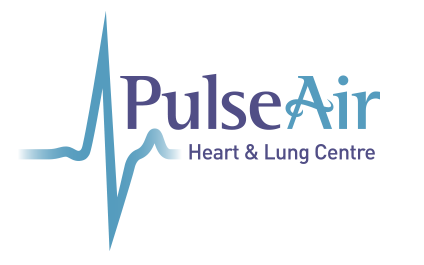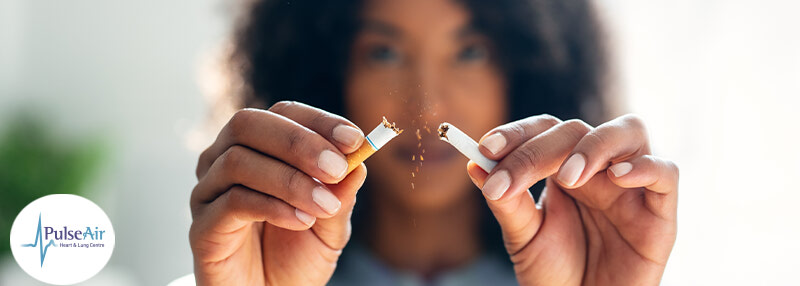May 31 is World No Tobacco Day, a global health initiative led by the World Health Organization to raise awareness of the harmful effects of tobacco and to encourage smokers to quit for good.
Whether you’ve been smoking for a few years or several decades, quitting smoking is one of the most powerful actions you can take to protect your health — especially if you live with a respiratory, cardiac, or sleep-related condition.
At PulseAir Heart and Lung Centre, we’ve seen firsthand how smoking impacts the lungs, the heart, and even how you sleep. But we’ve also seen the incredible improvements that come with quitting. Today, we’ll break down how smoking affects your health, why quitting is so important, and 7 practical tips to help you quit for good.
How Smoking Affects Your Health (Especially If You Already Have a Condition)
1. Your Lungs
- Smoking is the leading cause of COPD (chronic obstructive pulmonary disease), a group of progressive lung diseases that includes emphysema and chronic bronchitis.
- It increases the frequency and severity of asthma attacks and reduces overall lung function.
- Smoking damages the small airways and alveoli, making it harder for oxygen to get into your bloodstream.
2. Your Heart
- Smoking causes blood vessels to narrow, raising your blood pressure and heart rate.
- It contributes to plaque buildup in arteries, increasing your risk of heart attack and stroke.
- Quitting can significantly reduce your cardiovascular risk — even if you’ve smoked for years.
3. Your Sleep and Allergies
- Smoking worsens sleep apnea, a condition where your airway becomes blocked during sleep.
- It increases inflammation in the nasal passages and sinuses, leading to snoring, congestion, and poor-quality sleep.
- It also worsens allergy symptoms and may trigger frequent sinus infections.
In short: Smoking touches nearly every system in your body — but it hits the lungs, heart, and sleep health especially hard. If you’re already dealing with a condition in one of these areas, quitting becomes even more urgent.
Why It’s Never Too Late to Quit Smoking
No matter how long you’ve smoked or how many cigarettes you have a day, your body begins to repair itself as soon as you stop.
Here’s what happens when you quit:
- After 20 minutes: Heart rate and blood pressure start to normalize.
- After 48 hours: Carbon monoxide levels in your blood drop; oxygen levels improve.
- Within 2–12 weeks: Circulation and lung function improve.
- After 1 year: Risk of heart disease is cut in half.
- After 5–10 years: Risk of stroke and some cancers drops significantly.
It’s never too late to start healing.
7 Best Tips to Quit Smoking for Good
Quitting isn’t easy — but with the right strategies and support, it’s absolutely possible. Here are seven tried-and-true tips to help you quit smoking and stay smoke-free.
1. Set a Quit Date and Make a Plan
Choose a meaningful day to quit — World No Tobacco Day (May 31) is a great start!
Prepare for challenges ahead of time by identifying situations where you typically smoke and planning alternatives.
2. Know Your Triggers
Be aware of what makes you want to smoke. Common triggers include:
- Stress or boredom
- Drinking alcohol or coffee
- Driving or taking breaks at work
- Social situations
Once you know your triggers, you can avoid or replace them with healthier habits.
3. Try Nicotine Replacement Therapy (NRT)
Nicotine patches, gum, lozenges, sprays, and inhalers help manage withdrawal symptoms and cravings.
These products are widely available in Canada and can double your chances of quitting successfully.
4. Consider Prescription Medications
Talk to your doctor about medications like:
- Bupropion (Zyban) – reduces cravings and withdrawal symptoms
- Varenicline (Champix) – blocks the nicotine receptors in your brain, making smoking less pleasurable
These options are often covered under provincial or workplace health plans.
5. Seek Out Support
You don’t have to do this alone. Support improves your chances of success. Try:
- Calling a Canadian quitline (e.g., AlbertaQuits helpline is free to call at 1-866-710-7848)
- Joining a local support group or online community
- Using an app like Break It Off, a Health Canada-supported quit-smoking tool
6. Replace the Habit with Something Healthy
Keep your hands and mouth busy with:
- Sugar-free gum or mints
- A water bottle or stress ball
- Journaling or deep breathing exercises
- Going for a quick walk or doing light stretches when cravings hit
7. Celebrate Milestones
Reward yourself for hitting important goals — your first day, first week, first month.
Use the money you’re saving from not buying cigarettes to treat yourself to something healthy or fun.
How PulseAir Can Help You Quit (Even if We Don’t Run a Quit-Smoking Program)
While PulseAir doesn’t offer formal smoking cessation programs, we play a vital role in supporting your recovery, symptom management, and long-term health as you quit.
Here’s how we help:
1. Respiratory Care
- Pulmonary function testing to monitor lung health
- Support for asthma, COPD, and chronic cough
- Oxygen therapy and nebulizer equipment for patients with reduced lung function
2. Sleep Support
- Sleep studies for those with sleep apnea or smoking-related sleep issues
- CPAP therapy and mask fitting support
3. Cardiac Monitoring
- Screenings and assessments for high blood pressure, irregular heartbeat, or other heart issues
- Holter monitors and remote cardiac testing for long-term heart health
4. Medical Equipment & Home Solutions
- Nebulizers, air purifiers, humidifiers, and CPAP accessories
- Tools that improve quality of life and respiratory health at home
We also provide follow-up assessments for individuals who have recently quit smoking and want to monitor their progress.
Make This the Year You Quit for Good
If you’re thinking about quitting smoking, know this: you’re not alone, and it’s never too late. Whether you’re quitting for your lungs, your heart, your sleep — or for your family — this World No Tobacco Day is the perfect time to take that first step.
Let PulseAir Heart and Lung Centre be part of your support team. We’ll help you manage the effects of smoking on your health and guide you toward a healthier, smoke-free future.


